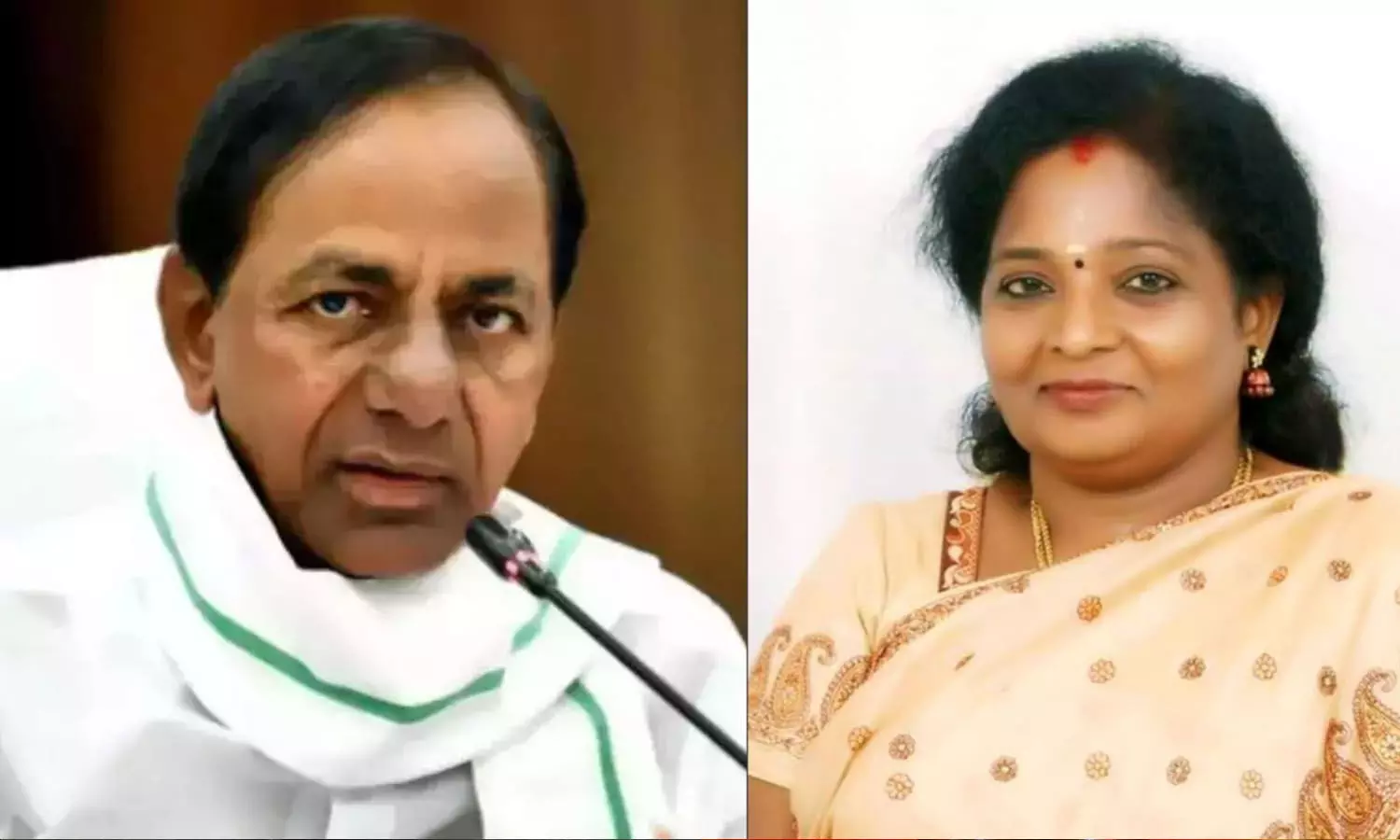As KCR plays hardball, Tamilisai unlikely at Telangana events for second straight year
The Telangana State Legislative Assembly and Legislative Council will commence the budget session on February 3, 2023 without the customary address of the Governor

HYDERABAD: In keeping with its most recent tradition, the Telangana State Legislative Assembly and Legislative Council will commence the budget session on February 3, 2023 without the customary address of the Governor. The session, which will see the presentation of the Telangana State Budget 2023-24 on the same day.
There is also uncertainty over Telangana Governor Dr Tamilisai Soundararajan’s presence and delivering the ceremonial address at the Republic Day 2023 parade this time around. A letter written by the Governor’s office seeking details of this year’s Republic Day celebrations and, more significantly, the copy of her speech, has so far been met with stoic silence from the government.
For the record, the budget session taking off devoid of the Governor’s address is a conspicuous deviation from an age-old legislative tradition. But for the discerning, keeping the first citizen of the state out of the loop is hardly a surprise, just like it happened during the 2022 budget session. A long-drawn out cold war between Pragathi Bhavan and the Raj Bhavan is obviously playing the catalyst, widening the gap by the day between the two key institutions in their showdown.
Here is a little lowdown on how the government is managing to circumvent the procedure to keep Dr Tamilisai Soundararajan out of the legislative business at the start of a session since 2022. The 2023 budget session is going to be the second straight instance to kick off without the governor’s address as the State Assembly has not been prorogued for well over one and a half years.
This is a double-edged sword that essentially provides the KCR regime a leeway to ensure that the State was not seen to be blatantly flouting the legislative rule book, at least on paper, while effectively banishing the governor from the precincts of the legislative House. Since there will be no governor’s speech, the two Houses will get on with their respective business, without bothering about a discussion on the ‘thanks-to-the-governor’s-speech’ motion.
Keeping the Governor at bay, the BRS government led by KCR for sure will not be seeing an avenging brownie point in it and instead treat it as a befelling constraint that spiralled out of one of the most tumultuous Governor-Chief Minister conflicts in the country’s history.
Tamilisai mission in Telangana
Unlike her predecessor E S L Narasimhan, who had established and groomed a harmonious relationship with Chief Minister K Chandrashekar Rao and his administration, Dr Tamilisai Soundararajan was more hawkish in her approach. After a quiet first few months in her office, the former president of BJP’s Tamil Nadu unit appeared to have suddenly switched into the top gear in her unprovoked confrontation with the State Government.
Choosing to ruffle the feathers of the State government on a slew of issues, she soon acquired the image of a ‘belligerent governor, not scared of exceeding her brief at the drop of the hat and running the playbook of the Delhi’s powers that be.’ One of her most glaring escapades came when she infamously attacked the Telagana government in Delhi after emerging out of her meetings with Prime Minister Narendra Modi, Union Home Minister Amit Shah and others who mattered in BJP.
She only appeared to have gone from strength to strength in her mission, uncharacteristic of a governor, to publicly criticise, ridicule and mock a government for which she is technically the figure-head. The governor’s brazen approach in hitting out at an elected government remained unchanged even when it was working to the advantage of KCR as the eternal fall-guy, amid the feeling that he grossly did not deserve the discourteous treatment from her. As the animosity – largely contrived and provoked from the Raj Bhavan – precipitated with time, KCR found himself in a politically compelling sphere where he had no option but to shun the Raj Bhavan.
Understandably, Tamilisai’s attempts to make a mountain out of this molehill with her acrimonious cries in public and playing the victim card found no takers except those in the BJP. Her passionate pleading, using every available public forum, that her fight was not against the political regime but was issue-based hasn’t really cut any ice with the Telangana society. Yet, the governor remains defiant and vows to continue questioning the wrongs even after being evaded by the administration and viewed as the puppet of the BJP-led NDA government at the Centre.
In fact, KCR and Dr Tamilisai saw eye to eye, for the first time in more than a year, during President Draupadi Murmu’s recent visit to Hyderabad. The two exchanging pleasantries and interacting with each other as if everything was hunky dory between them may have raised optimistic hopes among those wishing for the restoration of healthy ties between Pragathi Bhavan and the Raj Bhavan. But, the governor not being invited to address the Telangana Assembly budget session and the uncertainty over her presence at the Republic Day fete, for the second straight year, disproves all that as wishful thinking.
Troubles with governors, not just KCR’s predicament
Telangana Chief Minister K Chandrashekar Rao is not alone in weathering the gubernatorial turbulence in day-to-day administration. There are a handful of other chief ministers who either have endured troubles or continue to lock horns with their respective governors, for no rhyme or reason.
India was witness to how West Bengal Chief Minister Mamata Banerjee had to sword-fight and ward off the machinations of Jagdeep Dhankar as the state governor until his elevation as the Vice-President of India.
There were at least 14 instances of run-ins between Jagdeep Dhankar and Mamata Banerjee’s West Bengal Government that saw the trust deficit between the two key institutions hitting the rock bottom. In some of the controversies, which appeared to have set the roadmap for other governors in non-BJP-ruled states, especially, Dr Tamilisai Soundararajan, Dhankar was accused of behaving like an ‘RSS man’ and at the behest of of the Centre’ when he was criticised for sitting over crucial bills for unduly long time. The Trinamool Congress (TMC) Government retorted by highlighting the governor’s non-cooperation with a slew of protests both in Parliament and outside besides stripping him of his powers as the chancellor of universities in the state. Dhankar was also accused of ‘fishing in troubled waters’ at the height of a stormy protest at Jadavpur University when students accosted then Union Minister Babul Supriyo. The TMC did not take kindly to the governor rushing to the university in the garb of rescuing the singer-turned-BJP politician even brushing aside a request from Mamata Banerjee to not do so.
As things turned out in the subsequent years, parallels were drawn on how Dhankar set out the path for his counterparts in other states as part of a veiled campaign against democratically-elected non-BJP governments. Interestingly, what Dr Tamilsai Soundararajan did or continues to do so from Telangana Raj Bhavan appears to be running on the same lines. She too was accused by the KCR Government of delaying key bills for months, as if aimed at hampering the fiscal and administrative business in the state.
Her visits to IIIT-Basar or Rajiv Gandhi University of Knowledge Technologies (RGUKT) and flood-hit Bhadrachalam are also used by the BRS leaders as cases in point.
There is a growing and continuing trend of governors and lieutenant governors taking on elected chief ministers elsewhere in the country. AAP founder and Delhi Chief Minister Arwind Kejriwal and Delhi Lieutenant Governor Vinai Kumar Saxena are constantly in news for their public spats almost on a daily basis.
Shiv Sena chief Uddhav Thackeray, in his brief honeymoon as the chief minister of Maharashtra, too had his share of travails with Governor Bhagat Singh Koshyari. No exception was the case of Kerala Chief Minister Pinarayi Vijayan, who made no bones of his displeasure at what he alleged as the interference of Governor Arif Mohammed Khan in his administration. The Kerala cabinet had even decided to bring in an ordinance to remove the governor as the chancellor of universities in a bid to clip the latter’s wings.
The latest in the list of alleged troublesome governors is Tamil Nadu’s R N Ravi. He has stirred the hornet’s nest recently when he sought to alter the discourse on the appropriateness of the state calling itself Tamil Nadu. His unsolicited proposal to re-christen the State as Tamizhagam and his remarks on Dravidian culture raked up an unwarranted controversy.
Close on the heels of this incident was R N Ravi’s act of indiscretion when he was accused of consciously skipping a few portions of his speech and adding his own personalised remarks to it. The Governor, who was invited by the M K Stalin regime to deliver his address at the first session of the year, avoided references to B R Ambedkar and E V R Periyar, the Dravidian model of governance and the law and order situation in Tamil Nadu.
Stormy scenes were witnessed in the Assembly even as R N Ravi was chastised for his overbearing attitude and acting in a way unbecoming of a governor.
However, the story of governors sparring with elected governments in different states is neither the first time nor will it be the last.



